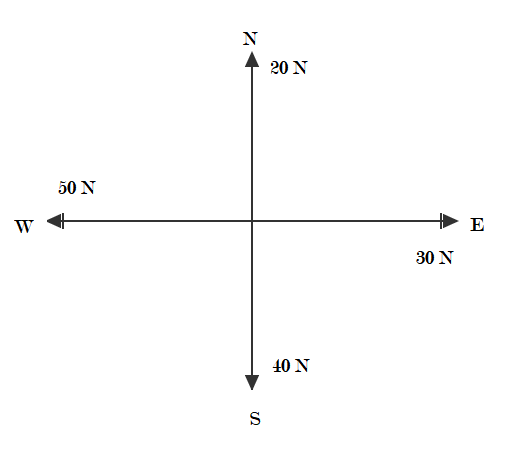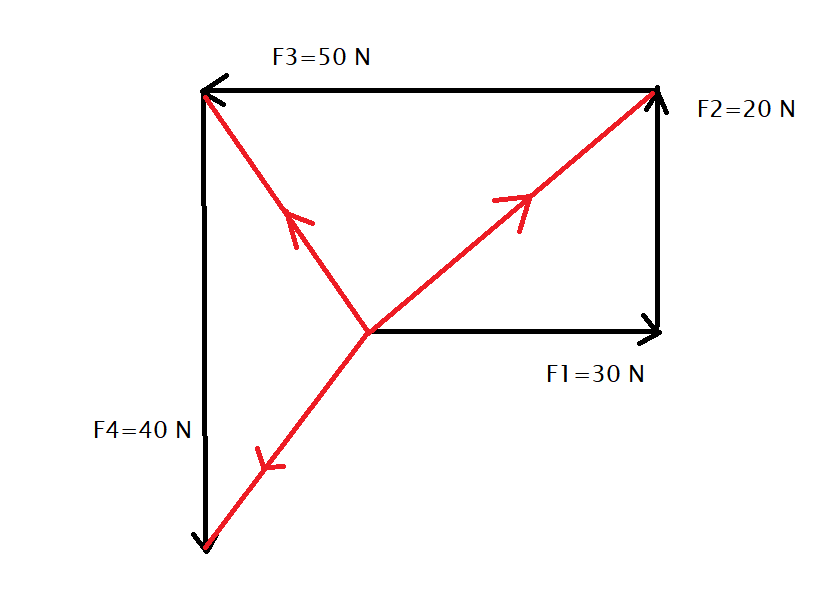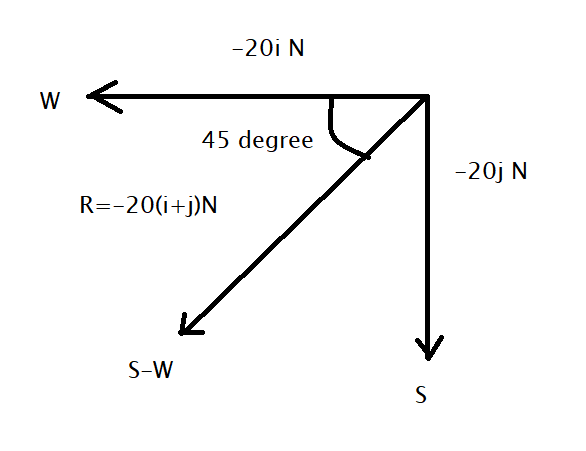
Calculate the resultant force, when four forces of $30\;N$ due to east, $20\;N$due to north, $50\;N$ due to west and $40\;N$ due to south, are acted upon by a body.
(A) $20\sqrt 2 N$, ${60^\circ }$, south-west
(B) $20\sqrt 2 N$, ${45^\circ }$, south-west
(C) $20\sqrt 2 N$, ${45^\circ }$, north-east
(D) $20\sqrt 2 N$, ${45^\circ }$, south-east
Answer
548.1k+ views
Hint: Here given that the four forces are acting on the object from four directions. To solve this question we will use the concept of cardinal directions, we will consider the north as $ + y$ axis while the south as $ - y$ axis, similarly use will consider the west as $ - x$ axis while east as $ + x$ axis. Hence we will evaluate the resultant vectors of the forces from all the directions by using the vector sum property.
Formula used:
Resultant force by vector sum property
$ \Rightarrow \vec R = {\vec F_1} + {\vec F_2} + {\vec F_3} + ...$
The angle between two vectors with a common origin
$ \Rightarrow \tan \theta = \dfrac{{{F_y}}}{{{F_x}}}$
Complete step by step solution:
From the given terms the following figure can be concluded.

We will evaluate the resultant force by using the vector sum property by using graphical representation as shown

Hence from the above figure, we can see that the forces can be given in the form of vector components such as
$ \Rightarrow {\vec F_1} = 30\hat iN$
$ \Rightarrow {\vec F_2} = 20\hat jN$
$ \Rightarrow {\vec F_3} = - 50\hat iN$
$ \Rightarrow {\vec F_4} = - 40\hat jN$
Now using the vector sum properties we will evaluate the resultant force as $\vec R$hence given as
$ \Rightarrow \vec R = {\vec F_1} + {\vec F_2} + {\vec F_3} + {\vec F_4}$
$ \Rightarrow \vec R = 30\hat iN + 20\hat jN + \left( { - 50\hat iN - 40\hat jN} \right)$
Now evaluating the sum of vectors results in
$ \Rightarrow \vec R = - 20\hat iN - 20\hat jN$
$ \Rightarrow \vec R = - 20N\left( {\hat i + \hat j} \right)$ …………$(1)$
Now we will evaluate the magnitude of the resultant by $\left| {\left. R \right|} \right.$.
$ \Rightarrow \left| R \right| = \sqrt {{{\left( { - 20N} \right)}^2}\left( {{{\hat i}^2} + {{\hat j}^2}} \right)} $
$\therefore R = 20\sqrt 2 N$
Therefore the resultant value of the force on the body is given as $R = 20\sqrt 2 N$.
Now we conclude that from the equation $(1)$ that the direction of the resultant force can be given as

Hence the direction of the resultant force concluded from a figure that is the south-west. The angle of the resultant force can be given as
$ \Rightarrow \tan \theta = \dfrac{{{F_y}}}{{{F_x}}}$
$ \Rightarrow \tan \theta = \dfrac{{ - 20}}{{ - 20}}$
$ \Rightarrow \tan \theta = 1$
Hence the angle is given by the inverse of $\tan \theta $ such as
$ \Rightarrow \theta = {\tan ^{ - 1}}1$
$\therefore \theta = {45^\circ }$
Therefore the resultant force acting on the body is $R = 20\sqrt 2 N$ at an angle of ${45^\circ }$ in the south-west direction.
Hence the correct answer is option (B) $20\sqrt 2 N$, ${45^\circ }$, south-west is.
Note:
When several forces act on a point, then their sum can be evaluated by using the rules of vector algebra. For the sum of forces acting we can use the triangular method as well as the parallelogram method. Here in this question, we have used the triangular method.
Formula used:
Resultant force by vector sum property
$ \Rightarrow \vec R = {\vec F_1} + {\vec F_2} + {\vec F_3} + ...$
The angle between two vectors with a common origin
$ \Rightarrow \tan \theta = \dfrac{{{F_y}}}{{{F_x}}}$
Complete step by step solution:
From the given terms the following figure can be concluded.

We will evaluate the resultant force by using the vector sum property by using graphical representation as shown

Hence from the above figure, we can see that the forces can be given in the form of vector components such as
$ \Rightarrow {\vec F_1} = 30\hat iN$
$ \Rightarrow {\vec F_2} = 20\hat jN$
$ \Rightarrow {\vec F_3} = - 50\hat iN$
$ \Rightarrow {\vec F_4} = - 40\hat jN$
Now using the vector sum properties we will evaluate the resultant force as $\vec R$hence given as
$ \Rightarrow \vec R = {\vec F_1} + {\vec F_2} + {\vec F_3} + {\vec F_4}$
$ \Rightarrow \vec R = 30\hat iN + 20\hat jN + \left( { - 50\hat iN - 40\hat jN} \right)$
Now evaluating the sum of vectors results in
$ \Rightarrow \vec R = - 20\hat iN - 20\hat jN$
$ \Rightarrow \vec R = - 20N\left( {\hat i + \hat j} \right)$ …………$(1)$
Now we will evaluate the magnitude of the resultant by $\left| {\left. R \right|} \right.$.
$ \Rightarrow \left| R \right| = \sqrt {{{\left( { - 20N} \right)}^2}\left( {{{\hat i}^2} + {{\hat j}^2}} \right)} $
$\therefore R = 20\sqrt 2 N$
Therefore the resultant value of the force on the body is given as $R = 20\sqrt 2 N$.
Now we conclude that from the equation $(1)$ that the direction of the resultant force can be given as

Hence the direction of the resultant force concluded from a figure that is the south-west. The angle of the resultant force can be given as
$ \Rightarrow \tan \theta = \dfrac{{{F_y}}}{{{F_x}}}$
$ \Rightarrow \tan \theta = \dfrac{{ - 20}}{{ - 20}}$
$ \Rightarrow \tan \theta = 1$
Hence the angle is given by the inverse of $\tan \theta $ such as
$ \Rightarrow \theta = {\tan ^{ - 1}}1$
$\therefore \theta = {45^\circ }$
Therefore the resultant force acting on the body is $R = 20\sqrt 2 N$ at an angle of ${45^\circ }$ in the south-west direction.
Hence the correct answer is option (B) $20\sqrt 2 N$, ${45^\circ }$, south-west is.
Note:
When several forces act on a point, then their sum can be evaluated by using the rules of vector algebra. For the sum of forces acting we can use the triangular method as well as the parallelogram method. Here in this question, we have used the triangular method.
Recently Updated Pages
Why are manures considered better than fertilizers class 11 biology CBSE

Find the coordinates of the midpoint of the line segment class 11 maths CBSE

Distinguish between static friction limiting friction class 11 physics CBSE

The Chairman of the constituent Assembly was A Jawaharlal class 11 social science CBSE

The first National Commission on Labour NCL submitted class 11 social science CBSE

Number of all subshell of n + l 7 is A 4 B 5 C 6 D class 11 chemistry CBSE

Trending doubts
What is meant by exothermic and endothermic reactions class 11 chemistry CBSE

10 examples of friction in our daily life

One Metric ton is equal to kg A 10000 B 1000 C 100 class 11 physics CBSE

1 Quintal is equal to a 110 kg b 10 kg c 100kg d 1000 class 11 physics CBSE

Difference Between Prokaryotic Cells and Eukaryotic Cells

What are Quantum numbers Explain the quantum number class 11 chemistry CBSE




